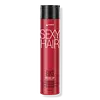What's inside
What's inside
 Key Ingredients
Key Ingredients

No key ingredients
 Benefits
Benefits

 Concerns
Concerns

 Ingredients Side-by-side
Ingredients Side-by-side

Water
Skin ConditioningDisodium Laureth Sulfosuccinate
CleansingSodium Lauroyl Methyl Isethionate
CleansingGlycerin
HumectantCocamidopropyl Betaine
CleansingCocamidopropyl Hydroxysultaine
CleansingPEG-150 Distearate
EmulsifyingParfum
MaskingPhenoxyethanol
PreservativeCocamidopropylamine Oxide
CleansingSodium Chloride
MaskingGuar Hydroxypropyltrimonium Chloride
Skin ConditioningEthylhexylglycerin
Skin ConditioningCitric Acid
BufferingBenzyl Salicylate
PerfumingSodium Benzoate
MaskingPolyquaternium-7
Linalool
PerfumingBenzoic Acid
MaskingHydrolyzed Collagen
EmollientWater, Disodium Laureth Sulfosuccinate, Sodium Lauroyl Methyl Isethionate, Glycerin, Cocamidopropyl Betaine, Cocamidopropyl Hydroxysultaine, PEG-150 Distearate, Parfum, Phenoxyethanol, Cocamidopropylamine Oxide, Sodium Chloride, Guar Hydroxypropyltrimonium Chloride, Ethylhexylglycerin, Citric Acid, Benzyl Salicylate, Sodium Benzoate, Polyquaternium-7, Linalool, Benzoic Acid, Hydrolyzed Collagen
Water
Skin ConditioningSodium Methyl Cocoyl Taurate
CleansingCocamidopropyl Hydroxysultaine
CleansingCocamidopropylamine Oxide
CleansingGlycerin
HumectantCocamidopropyl Betaine
CleansingGlyceryl Laurate
EmollientEpilobium Angustifolium Flower/Leaf/Stem Extract
Skin ConditioningSalix Alba Bark Extract
AstringentSodium Chloride
MaskingPanthenol
Skin ConditioningSalicylic Acid
MaskingMenthol
MaskingMelaleuca Alternifolia Leaf Oil
AntioxidantArctium Lappa Root Extract
Skin ConditioningChamomilla Recutita Flower Extract
MaskingArctostaphylos Uva-Ursi Leaf Extract
Skin ConditioningMelia Azadirachta Extract
Skin ConditioningVitex Trifolia Extract
Skin ConditioningBerberis Aquifolium Extract
Skin ConditioningZanthoxylum Zanthoxyloides Bark Extract
Skin ConditioningPhenoxyethanol
PreservativeEthylhexylglycerin
Skin ConditioningTocopheryl Acetate
AntioxidantAloe Barbadensis Leaf Juice
Skin ConditioningWater, Sodium Methyl Cocoyl Taurate, Cocamidopropyl Hydroxysultaine, Cocamidopropylamine Oxide, Glycerin, Cocamidopropyl Betaine, Glyceryl Laurate, Epilobium Angustifolium Flower/Leaf/Stem Extract, Salix Alba Bark Extract, Sodium Chloride, Panthenol, Salicylic Acid, Menthol, Melaleuca Alternifolia Leaf Oil, Arctium Lappa Root Extract, Chamomilla Recutita Flower Extract, Arctostaphylos Uva-Ursi Leaf Extract, Melia Azadirachta Extract, Vitex Trifolia Extract, Berberis Aquifolium Extract, Zanthoxylum Zanthoxyloides Bark Extract, Phenoxyethanol, Ethylhexylglycerin, Tocopheryl Acetate, Aloe Barbadensis Leaf Juice
Ingredients Explained
These ingredients are found in both products.
Ingredients higher up in an ingredient list are typically present in a larger amount.
Cocamidopropyl Betaine is a fatty acid created by mixing similar compounds in coconut oil and dimethylaminopropylamine, a compound with two amino groups.
This ingredient is a surfactant and cleanser. It helps gather the dirt, pollutants, and other impurities in your skin to be washed away. It also helps thicken a product and make the texture more creamy.
Being created from coconut oil means Cocamidopropyl Betaine is hydrating for the skin.
While Cocamidopropyl Betaine was believed to be an allergen, a study from 2012 disproved this. It found two compounds in unpure Cocamidopropyl Betaine to be the irritants: aminoamide and 3-dimethylaminopropylamine. High-grade and pure Cocamidopropyl Betaine did not induce allergic reactions during this study.
Learn more about Cocamidopropyl BetaineCocamidopropyl Hydroxysultaine is a synthetic cleansing agent, though it is derived from coconut oil.
It is used to enhance the texture of products by boosting lather and thickening the texture. As a cleanser, Cocamidopropyl Hydroxysultaine is mild.
We don't have a description for Cocamidopropylamine Oxide yet.
Ethylhexylglycerin (we can't pronounce this either) is commonly used as a preservative and skin softener. It is derived from glyceryl.
You might see Ethylhexylglycerin often paired with other preservatives such as phenoxyethanol. Ethylhexylglycerin has been found to increase the effectiveness of these other preservatives.
Glycerin is already naturally found in your skin. It helps moisturize and protect your skin.
A study from 2016 found glycerin to be more effective as a humectant than AHAs and hyaluronic acid.
As a humectant, it helps the skin stay hydrated by pulling moisture to your skin. The low molecular weight of glycerin allows it to pull moisture into the deeper layers of your skin.
Hydrated skin improves your skin barrier; Your skin barrier helps protect against irritants and bacteria.
Glycerin has also been found to have antimicrobial and antiviral properties. Due to these properties, glycerin is often used in wound and burn treatments.
In cosmetics, glycerin is usually derived from plants such as soybean or palm. However, it can also be sourced from animals, such as tallow or animal fat.
This ingredient is organic, colorless, odorless, and non-toxic.
Glycerin is the name for this ingredient in American English. British English uses Glycerol/Glycerine.
Learn more about GlycerinPhenoxyethanol is a preservative that has germicide, antimicrobial, and aromatic properties. Studies show that phenoxyethanol can prevent microbial growth. By itself, it has a scent that is similar to that of a rose.
It's often used in formulations along with Caprylyl Glycol to preserve the shelf life of products.
Chances are, you eat sodium chloride every day. Sodium Chloride is also known as table salt.
This ingredient has many purposes in skincare: thickener, emulsifier, and exfoliator.
You'll most likely find this ingredient in cleansers where it is used to create a gel-like texture. As an emulsifier, it also prevents ingredients from separating.
There is much debate on whether this ingredient is comedogenic. The short answer - comedogenic ratings don't tell the whole story. Learn more about comegodenic ratings here.
The concensus about this ingredient causing acne seems to be divided. Research is needed to understand if this ingredient does cause acne.
Scrubs may use salt as the primary exfoliating ingredient.
Learn more about Sodium ChlorideWater. It's the most common cosmetic ingredient of all. You'll usually see it at the top of ingredient lists, meaning that it makes up the largest part of the product.
So why is it so popular? Water most often acts as a solvent - this means that it helps dissolve other ingredients into the formulation.
You'll also recognize water as that liquid we all need to stay alive. If you see this, drink a glass of water. Stay hydrated!
Learn more about Water